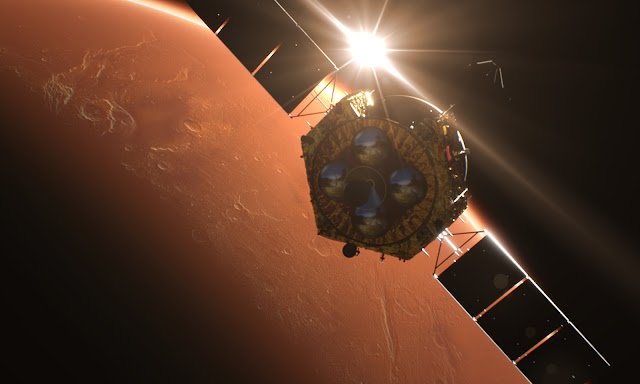CNSA - Tianwen-1 (天問-1) Mission to Mars logo.
Jan 9, 2023
The two spacecraft making up China’s first interplanetary mission are both suffering issues, with the rover potentially lost on the surface after winter hibernation.
The Zhurong Mars rover has been hibernating on the Martian surface since May 18 last year and was expected to resume activity in December, around the time of the Spring equinox in the northern hemisphere.
Image above: China's Zhurong images its own parachute from a distance of 30 meters, July 12, 2021. Image Credits: CNSA/PEC.
However no announcement of establishing contact with the rover has been made. The South China Morning Post reported Jan. 7, citing sources that do not wish to be named, that teams on Earth have yet to receive a signal from Zhurong.
The Zhurong rover landed in Mars’s Utopia Planitia region in May 2021 but entered a period of hibernation to ride out winter, when both temperatures and solar radiation levels are too low for the solar-powered rover to operate.
The rover was expected to autonomously resume activities once it can generate sufficient energy from solar power and when temperatures reach around minus 15 degrees Celsius.
Zhurong entered hibernation when local temperatures were around minus 20 degrees, according to the Chinese Lunar Exploration Program, after the autumn equinox in late February. Conditions should already by more favorable following the Spring equinox on Dec. 26. Mars has an axial tilt of around 25 degrees, meaning it has has similar seasonal variations to Earth during its orbit around the sun.
While there has so far been no official comment, the rover may have been impacted by sand storms in the area, which could reduce the levels of energy generation. The Tianwen-1 orbiter noted storms around the landing area in March and April 2021.
Zhurong has active means of removing dust from its four butterfly wing solar arrays, but would be unable to perform this operation while hibernating. The arrays also have an anti-dust coating and can tilt to maximize light collection.
Zhurong had a primary mission lifetime of three Earth months but operated for just over one Earth year in Utopia Planitia, traveling at least 1,921 meters south from its landing site. It was seeking out geomorphologic targets such as mud volcanoes during its extended mission.
The rover has returned detailed insights into the local layered subsurface with its ground-penetrating radar and discovered evidence of relatively recent aqueous activity in the area. The rover landing was also used by NASA Administrator Bill Nelson as a warning to Congress as to China’s competitive threat to American leadership in human spaceflight.
Meanwhile the Tianwen-1 orbiter has been tasked with assessing the area and attempting to contact the rover. Teams are however also having trouble receiving data from the orbiter, according to SCMP.
Radio amateurs have also noted issues with attempts for ground stations to lock onto the orbiter.
Tianwen-1 was scheduled to conduct aerobraking tests late last year as part of preparation for a Mars sample return mission potentially launching later this decade. It is unknown if the tests have been conducted and potentially impacted the orbiter. Chinese space authorities have yet to comment on the situation.
The Tianwen-1 orbiter was initially used to assess the pre-selected landing zones for Zhurong. It was then used primarily as a communications relay for Zhurong during the rover’s primary mission phase, before then switching to focus more on its own science objectives.
It completed a mapping of the Martian surface with a medium-resolution camera by June 2022, and also completed its assigned goals for its six science payloads.
Tianwen-1 orbiter
China launched its Tianwen-1 mission to Mars in July 2020 with the combination of the Tianwen-1 orbiter and Zhurong rover entering Mars orbit in February 2021.
Both Tianwen-1 and Zhurong had entered a standby mode in 2021 when the Earth and Mars were orbiting at opposite sides of the sun, causing a communications blackout.
China plans to launch the Tianwen-2 joint near-Earth asteroid sample-return and main belt comet rendezvous mission around 2025.
Related link:
For more information about China National Space Administration (CNSA), visit: http://www.cnsa.gov.cn/
Images, Text, Credits: CNSA/PEC/Twitter/SpaceNews/by Andrew Jones.
Greetings, Orbiter.ch






